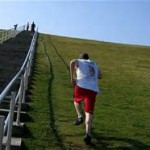Standing Inner Thigh and Hamstring Stretch
Do this stretch for runners after your next workout. Begin standing and pull your right foot up in front of your belly button. Move your right knee to the side of your body. Hold your lower leg and ankle with both hands, keeping your lower leg parallel to the floor. Keep your torso straight and shoulders back. Hold for 10-30 seconds, then release. Repeat pulling your left foot up in front of your body. Using both hands hold your left calf and ankle, letting your knee fall to the side. Hold for 10-30 seconds, then release.
*Consult your physician before beginning exercise. This stretch is for those without injury concerns.
 Subscribe
Subscribe







